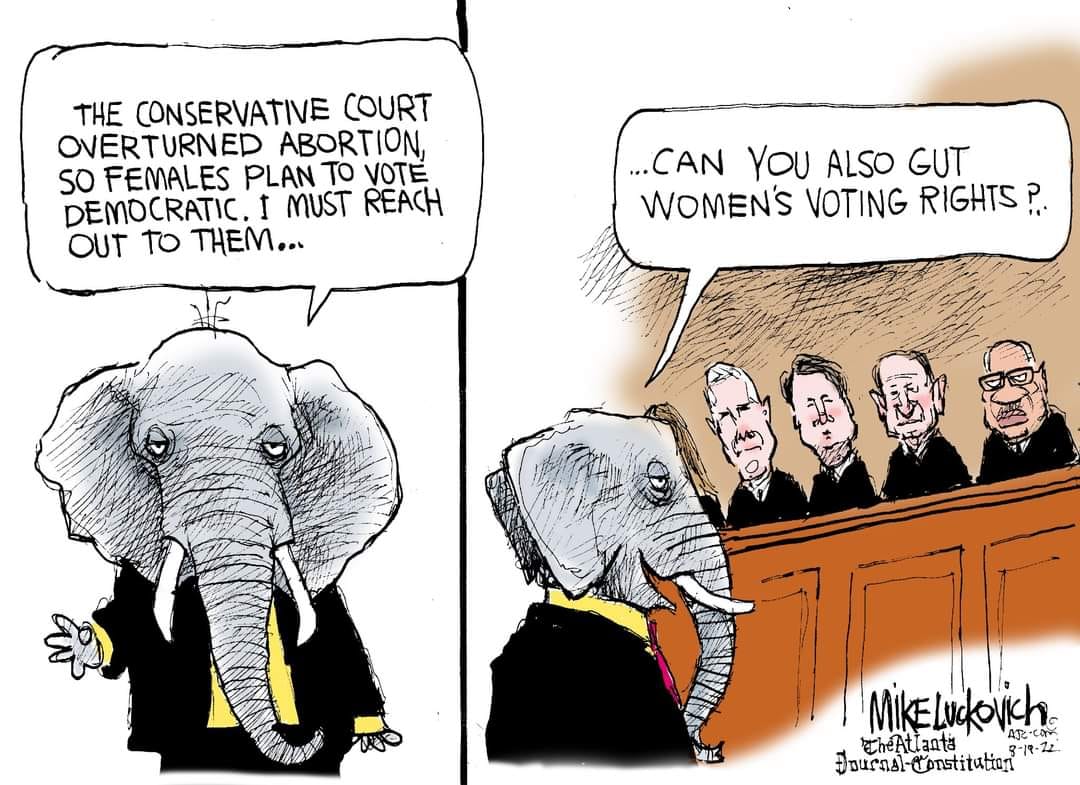By Glynn Wilson –
Look out people. The United States Supreme Court is about to go back into session and more rights are on the line as the high court faces the lowest public approval in American history.
According to the latest Gallup poll, nearly 60 percent of Americans disapprove of this conservative court, made up mainly of Republican justices appointed by presidents Donald Trump and George W. Bush. They hold a rare 6-3 majority.
Less than half the adults in the country, 47 percent, now say they have “a great deal” or “a fair amount” of trust in the entire judicial branch of the federal government headed by the Supreme Court, a whopping 20-percentage-point drop from just two years ago. The court lost seven percentage points just in the past year, and is now the lowest in Gallup’s entire trend line by six points.
“By all Gallup measures, then, Americans’ opinions of the Supreme Court are the worst they have been in 50 years of polling,” Gallup says in its analysis of the numbers.
Approval of the Supreme Court fell from 49 percent in July 2021 to 40 percent last September, just after the court allowed a restrictive Texas abortion law to go into effect. In July 2022, only 43 percent approved after the court’s ruling in the Dobbs v. Jackson Women’s Health Organization case that struck down the 1973 Roe v. Wade decision that had limited the ability of states to restrict abortion.
Trust in many U.S. institutions has declined in recent years, Gallup points out, “but the loss of faith in the Supreme Court is especially notable, given the high levels of trust it has enjoyed historically.”
The court has come under criticism for a series of rulings in its last term that aligned with conservative policy preferences, including on abortion, environmental policy, gun laws and the separation of church and state.
Related Coverage
Trump Supreme Court Dismantles Wall of Separation Between Church and State
Conservative Supreme Court Strikes Down Federal Power to Fight Global Warming and Climate Change
Supreme Court Dismantles Liberty, Rights and Freedoms, and Not Just for Women
Welcome the First African American Woman to the U.S. Supreme Court
Six of the nine justices now are conservative-leaning, after former President Donald Trump’s three Supreme Court nominees were seated during his disastrous tenure.
Some of the sitting justices have publicly addressed criticisms of the court’s rulings in the past year.
Liberal critics of the court have pressured the Biden administration and Congress to take steps to try to move the court in a more left-leaning direction, including by adding more justices to the court or by limiting the tenure of justices or the jurisdiction of the court. President Joe Biden agreed to study the issue, and a bipartisan commission he set up issued a report late last year. The commission declined to make recommendations on these proposed changes, noting the division among its members on many of the proposals they studied.
Biden made his first Supreme Court nomination this year. New Justice Ketanji Brown Jackson replaced another liberal, Stephen Breyer, and that membership change will not diminish the strength of the conservative majority.
The justices themselves are openly debating what the court’s rightward turn has meant for its institutional integrity, according to coverage in The Washington Post.
Chief Justice John G. Roberts Jr. has defended his conservative colleagues, with whom he does not always agree, saying unpopular decisions should not call the court’s legitimacy into question.
But on the other side, liberal Justice Elena Kagan increasingly is sounding an alarm about the next precedents that could fall and the implications for public perception of the bench.
“The court shouldn’t be wandering around just inserting itself into every hot-button issue in America, and especially it shouldn’t be doing that in a way that reflects one ideology or one set of political views over another,” Kagan said last week at Salve Regina, a Roman Catholic university in Rhode Island.
She said that disregarding stare decisis — the doctrine of abiding by past decisions in the absence of compelling evidence that change is required — undermines public confidence.
“It just doesn’t look like law when some new judges appointed by a new president come in and start just tossing out the old stuff,” she said.
The court’s new docket offers more potential for the court to interject itself into public affairs in a political way.
The court has agreed to revisit whether universities can use race in a limited way when making admission decisions, a practice the court has endorsed since 1978.
Two major cases involve voting rights.
The court again will consider whether laws forbidding discrimination on the basis of sexual orientation must give way to business owners who do not want to provide wedding services to same-sex couples.
And after limiting the Environmental Protection Agency’s authority in air pollution cases last term, the court will hear a challenge regarding the Clean Water Act this term.
On this court’s shoulders may very well rest the very survival of the human species on planet Earth, and seven of the justices are basically Catholics who probably don’t care — Chief Just John Roberts, Clarence Thomas, Samuel Alito, Brett Kavanaugh, Amy Coney Barrett and Sonia Sotomayor. Ketanji Brown Jackson told South Carolina Senator Lindsey Graham during her confirmation that she was a nondenominational Protestant. Neil Gorsuch is Episcopalian but was raised Catholic, and Elena Kagan is Jewish.
“Thus,” according to Gallup, in a line that sounds like a joke about walking into a bar, “the court will consist of six Catholics, two Protestants, and one Jew.”
Retired Justice Stephen G. Breyer, who handpicked Jackson as his replacement, declared his last term on the court “very frustrating” in a recent interview with CNN. Breyer was known during his tenure for pragmatism and trying to reach compromise, and he seemed to warn the conservative majority about making bold moves.
“You start writing too rigidly . . . the world will come around and bite you in the back,” he said.
The Dobbs decision has women all over the country on Facebook declaring that a RoeVember Revolution is coming, with women voting in record numbers.
“For many, that was a cause for great celebration,” said Irv Gornstein, the executive director of the Supreme Court Institute at the Georgetown Law Center. “For many others, it shattered their faith in the Supreme Court. Inside the court, Dobbs has provoked a deeply divisive debate on what it means for the court to act with legitimacy.”
President Joe Biden invoked Alito last week, the justice who wrote the majority decision, at a gathering of Democratic activists, where he said Republicans loyal to Trump “just cheered and embraced the first Supreme Court decision in our entire history — the first one in our entire history that just didn’t fail to preserve a constitutional freedom, it actually took away a fundamental right.”
“Justice Alito said that women can decide the outcome of this election,” he said, paraphrasing a quote in the actual decision. “Well, he ain’t seen nothing yet.”
Partisan Divide
Since 1993, Gallup has asked Americans to say whether they believe the Supreme Court is too liberal, too conservative, or about right. Until now, the plurality has always described the court as “about right.” In the latest survey, 42 percent say the court is too conservative — a new high for that response — while 38 percent say it is about right, and only 18 percent say it is too liberal.
Both the “too liberal” and “about right” percentages are at or near their low points in Gallup’s trend.
The drop in trust in the federal judicial branch since September 2021 is driven largely by a sharp decline among Democrats, according to Gallup’s numbers. Only 25 percent of Democrats now have a great deal or fair amount of trust in the court, down from 50 percent only a year ago.
Last year, Republicans and independents had larger losses of faith in the judicial branch than Democrats. This year, Republican trust is up modestly, while fewer independents trust the judicial branch.
“The new poll marks the first time that less than half of Democrats and independents express faith in the judicial branch,” Gallup says. “Republicans’ trust fell below the majority level in 2015 and 2016 — although not as low as Democrats’ trust is today — after court rulings that legalized same-sex marriage and upheld the Affordable Care Act.”
Only 36 percent of independents and 23 percent of Democrats now say they approve of the Supreme Court.
In describing the high court’s ideology, the vast majority of Democrats, 71 percent, say the Supreme Court is “too conservative.” And 46 percent of independents say the same.
While 58 percent of Republicans say the court has the balance “about right,” even 11 percent say it is “too conservative.”
What do you say, and how do you plan to vote in November?
___
If you support truth in reporting with no paywall, and fearless writing with no popup ads or sponsored content, consider making a contribution today with GoFundMe or Patreon or PayPal.
Before you continue, I’d like to ask if you could support our independent journalism as we head into one of the most critical news periods of our time in 2024.
The New American Journal is deeply dedicated to uncovering the escalating threats to our democracy and holding those in power accountable. With a turbulent presidential race and the possibility of an even more extreme Trump presidency on the horizon, the need for independent, credible journalism that emphasizes the importance of the upcoming election for our nation and planet has never been greater.
However, a small group of billionaire owners control a significant portion of the information that reaches the public. We are different. We don’t have a billionaire owner or shareholders. Our journalism is created to serve the public interest, not to generate profit. Unlike much of the U.S. media, which often falls into the trap of false equivalence in the name of neutrality, we strive to highlight the lies of powerful individuals and institutions, showing how misinformation and demagoguery can harm democracy.
Our journalists provide context, investigate, and bring to light the critical stories of our time, from election integrity threats to the worsening climate crisis and complex international conflicts. As a news organization with a strong voice, we offer a unique, outsider perspective that is often missing in American media.
Thanks to our unique reader-supported model, you can access the New American journal without encountering a paywall. This is possible because of readers like you. Your support keeps us independent, free from external influences, and accessible to everyone, regardless of their ability to pay for news.
Please help if you can.
American journalists need your help more than ever as forces amass against the free press and democracy itself. We must not let the crypto-fascists and the AI bots take over.
See the latest GoFundMe campaign here.
Don't forget to listen to the new song and video.
Just because we are not featured on cable TV news talk shows, or TikTok videos, does not mean we are not getting out there in search engines and social media sites. We consistently get over a million hits a month.
Click to Advertise Here















